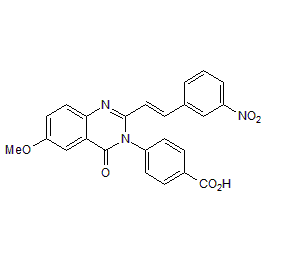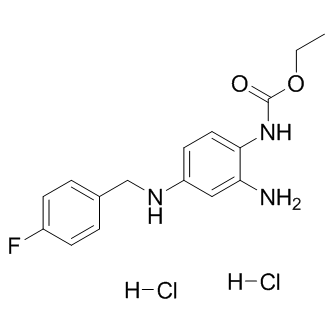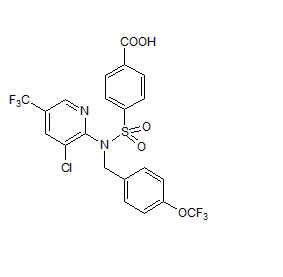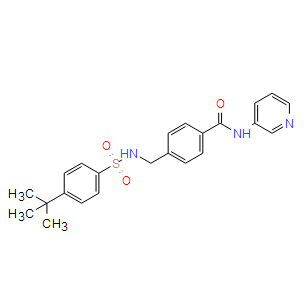 To enhance service speed and avoid tariff delays, we've opened a US warehouse. All US orders ship directly from our US facility.
To enhance service speed and avoid tariff delays, we've opened a US warehouse. All US orders ship directly from our US facility.
| Cat. No. | Product Name | Field of Application | Chemical Structure |
|---|---|---|---|
| DC70968 | Fenoverine |
Fenoverine is an antispasmodic drug and inhibits calcium channel currents. Fenoverine induces rhabdomyolysis.
More description
|

|
| DC70954 | MRS4738 |
MRS4738 is a potent and high affinity P2Y14R antagonist. MRS4738 exhibits anti-hyperallodynic and antiasthmatic activity in vivo.
More description
|

|
| DC8307 | QNZ46 Featured |
QNZ is a NR2C/NR2D-selective NMDA receptor non-competitive antagonist (IC50 values are 3, 6, 229, and >300, >300 μM for NR2D, NR2C, NR2A, NR2B, and GluR1, respectively).
More description
|

|
| DC9162 | Ranolazine HCl Featured |
Ranolazine(RS-43285) is an antianginal agent with antiarrhythmic properties that achieves its effects via a novel mechanism of action (inhibition of the late phase of the inward sodium current), without affecting heart rate or blood pressure (BP).
More description
|

|
| DC8175 | Rapastinel(GLYX-13) Featured |
Rapastinel(GLYX-13) is a NMDA receptor partial agonist that acts at the glycine site.
More description
|

|
| DC8807 | Retigabine dihydrochloride Featured |
Retigabine 2Hcl (Ezogabine; D23129) is a Kv7.2-7.5 (KCNQ2-5) neuronal potassium channel opener witrh anticonvulsant activity.
More description
|

|
| DC7490 | Rostafuroxin Featured |
Rostafuroxin: an ouabain-inhibitor counteracting specific forms of hypertension.
More description
|

|
| DC8306 | RQ-00203078 Featured |
RQ-00203078 is a potent TRPM8 antagonist (IC50 values are 5.3 and 8.3 nM for rat and human channels respectively).
More description
|

|
| DC9722 | SKF96365 Featured |
SKF96365 is blocker of TRP cation channels. Inhibits capacitative Ca2+ entry.
More description
|

|
| DC8359 | STF-31 Featured |
STF-31 is an inhibitor of GLUT1 (IC50 = ~1 µM) that blocks glucose uptake.
More description
|

|
| DC7306 | TAK-438 Featured |
TAK-438 is a novel P-CAB (potassium-competitive acid blocker) that reversibly inhibits H+/K+, ATPase with IC50 of 19 nM (pH 6.5), controls gastric acid secretion.
More description
|

|
| DC8824 | Traxoprodil Featured |
Traxoprodil is an NMDA ε 2 (NR2B) antagonist that has been studied as an alternative to serotonin selective reuptake inhibitors.
More description
|

|
| DC11472 | TRPM8 antagonist 14 Featured |
TRPM8 Antagonist is a potent and selective TRPM8 antagonist, with an IC50 of 0.2 nM, used in the research of neuropathic pain syndromes.
More description
|

|
| DC9958 | U 93631 Featured |
U93631 is a GABAA receptor ligand of novel chemical structure with IC50 of 100 nM,and has been shown to induce a rapid, time-dependent decay of GABA-induced whole-cell Cl-currents in recombinant GABAA receptors.
More description
|

|
| DC9813 | Valspodar(PSC833) Featured |
Valspodar(PSC833) is a P-glycoprotein (P-gp) inhibitor widely used in preclinical and clinical studies for overcoming multidrug resistance (MDR).
More description
|

|
| DC10029 | Verinurad Featured |
Verinurad is an urate transporter inhibitor with EC50 value of 0.05 μM.Verinurad is useful in the modulation of blood or serum uric acid levels, reducing serum uric acid levels in a human.
More description
|

|
| DC1059 | Lumacaftor(vx-809,vx809) Featured |
VX-809 is a CFTR modulator with EC50 of 0.1 μM.
More description
|

|
| DC9369 | YHO-13177 Featured |
YHO-13177 is a potent and specific inhibitor of BCRP; potentiated the cytotoxicity of SN-38 in cancer cells and no effect on P-glycoprotein–mediated paclitaxel resistance in MDR1-transduced human leukemia K562 cells.
More description
|

|
| DC9962 | YM-58483 Featured |
YM-58483 is the first selective and potent inhibitor of CRAC channels and subsequent Ca2+ signals.
More description
|

|
| DC70914 | YHV98-4 |
YHV98-4 is a selective inhibitor of proton-selective ion channel Hv1 with IC50 of 0.7 uM;
YHV98-4 displays no inhibitory effects against other channels containing VSDs, including hERG, KCNQ2, BK, and Nav1.7 channel.
YHV98-4 did not inhibit transient receptor potential V1 (TRPV1) or A1 (TRPA1) at 20 uM, which also contains VSD-like domain.
YHV98-4 restores impaired ROS-mediated inflammatory pathway, restores impaired ROS-SHP-1-PI3K/pAKT-CXCL1 pathway and attenuates morphine-induced hyperalgesia and tolerance.
More description
|

|
| DC70907 | XAF-1407 |
XAF-1407 (XAF1407) is a novel putatively potent and highly specific IK,Ach (Kir3.1/3.4 and Kir3.4/3.4) inhibitor (IC50 of 1.1 and 3.2 nM, respectively).XAF-1407 displays highly selectivity other relevant cardiac ion channels, with selectivity ratios for Kir3.1/3.4 of >2,000–8,000 fold up to >27,000 fold for Nav1.5 and Kir2.1, respectively.XAF-1407 potently and selectively inhibited Kir 3.1/3.4 and Kir 3.4/3.4, underlying the IK,ACh current.XAF-1407 treatment in horses prolonged atrial effective refractory period as well as decreased atrial fibrillatory rate significantly and successfully cardioverted atrial fibrillation (AF), although with a decreasing efficacy over time. XAF-1407 shortened atrioventricular-nodal refractoriness, without effect on QRS duration.
More description
|

|
| DC70898 | VU6036720 |
VU6036720 (VU 6036720) is the first potent, selective inhibitor of heteromeric Kir4.1/Kir5.1 (KCNJ10/KCNJ16) with IC50 of 0.24 uM.VU6036720 displays >30-fold selective for Kir4.1/5.1 over homomeric Kir4.1 channels, Kir1.1, Kir2.1, Kir2.2, Kir2.3, Kir4.2, Kir6.2/SUR1, Kir6.1/SUR2b and Kir7.1.VU6036720 inhibits Kir4.1/5.1 activity through a reduction of channel open-state probability and single-channel current amplitude, does not induce diuresis in vivo.VU6036720 showwd an IC50 in 3 uM in Tl+ flux assays, approximately 7-times more potent at inhibiting Kir4.1/5.1 than fluoxetine and amitriptyline.VU6036720 represents the current state-of-the-art Kir4.1/5.1 inhibitor that should be useful for probing the functions of Kir4.1/5.1 in vitro and ex vivo.
More description
|

|
| DC70892 | VU0468554 |
VU0468554 (VU 0468554) is a nove potent, selective inhibitor of GIRK channel with IC50 of 0.85 and 2.6 uM for GIRK1/GIRK4 and GIRK1/GIRK2 in cellular assays.VU0468554 more effectively inhibits the cardiac GIRK channel than the neuronal GIRK channel, inhibits Gβγ-activated GIRK channels in noncompetitive and potentially uncompetitive fashion.VU0468554 competitively inhibits GIRK-channel activation by ML297, a GIRK-channel activator.In the isolated heart model, VU0468554 partially reversed carbachol-induced bradycardia in hearts from wild-type mice but not Girk4-/- mice.
More description
|

|
| DC70877 | USP5-Cav3.2 inhibitor II-1 |
USP5-Cav3.2 inhibitor II-1 is a small molecule inhibitor of USP5-Cav3.2 interaction, without affecting the enzymatic activity of USP5.II-1 inhibited both phases of formalin-induced nocifensive behaviors in mice.Cav3.2 is required for the action of II-1.II-1 also mediated a robust inhibition of mechanical allodynia induced by injury to the sciatic nerve.
More description
|

|
| DC70830 | TC-6683 |
TC-6683 (AZD1446) is a potent and highly selective α4β2 nAChR agonist with Ki of 30/34 nM against hα4β2/rα4β2, with little to no affinity against h α3β2 and h α7 (Ki>6.7 uM).TC-6683 (10 uM) produced <30% inhibition of specific binding or enzyme activity at all targets except the human (87%) and murine (97%) 5-HT3 receptors at a panel of 70 receptors, ion channels, and enzymes at NovaScreen/Caliper.TC-6683 (AZD1446) enhanced working memory in the object recognition paradigm in rats at every dose tested (0.1−3 mg/kg, po), exhibited favorable pharmaceutical properties and in vivo efficacy in animal models.
More description
|

|
| DC70827 | tatM2NX |
tatM2NX is a novel potent, selective, cell permeable, peptide TRPM2 channel antagonist with IC50 of 396 nM, IC90 of 2 uM (TRPM2 channel currents), prevents ligand binding and TRPM2 activation.tatM2NX interacts with the ADPR binding site on the NUT9-H domain of TRPM2 channel. tatM2NX inhibits TRPM2-mediated dephosphorylation of GSK3β (activation), tatM2NX demonstrated selective neuroprotective effects in a mouse model of focal ischemia (stroke).
More description
|

|
| DC70811 | STS66 |
STS66 is a novel BBB-penetrant NKCC1 inhibitor.STS66 treatment completely blocked the ischemia-induced elevation of pNKCC1, which is superior to BMT and STS5.STS66 showed efficacy against permanent focal ischemic brain injury with hypertension comorbidity.
More description
|

|
| DC70804 | SSCI-1 |
SSCI-1 is a highly potent, selective NaV1.7 inhibitor with IC50 of 27 and 82 nM on human and rhesus Nav1.7 channels, respectively.SSCI-1 showed robust selectivity over other human and rhesus Nav channel paralogs, with the exception of Nav1.2 channels (IC50 252 nM for hNaV1.2), shows no other channels and receptors in 114 enzymatic, radioligand binding, and cellular assays.SSCI-1 also exhibits high potency in manual patch clamp experiments (IC50=66/295 nM for huma/rhesus Nav1.7 channels).SSCI-1 does not affect myelinated nerve excitability as measured by TT, SSCI-1 inhibits odorant-induced olfaction in the olfactory bulb of rhesus monkeys, measured by fMRI.SSCI-1 inhibits withdrawal responses to noxious heat in rhesus monkeys.
More description
|

|
| DC70774 | SH045 |
SH045 (SH-045, Larixyl-6-N-methylcarbamate) is a potent, selective TRPC6 antagonist (blocker) with IC50 of 63 nM.SH045 displays 13-fold subtype selectivity over TRPC3 in stably expressing HEK293 cells.Treatment of isolated perfused lung preparations with SH045 led to a decrease in lung ischemia-reperfusion edema (LIRE), a life-threatening condition associated with TRPC6 that may occur after organ transplantation.
More description
|

|
| DC70738 | RJR-2403 hemioxalate |
RJR-2403 (Rivanicline, Metanicotine) is a potent, selective neuronal nicotinic ACh (nAChR) agonist with high affinity to rat brain cortex (Ki=26 nM), does not significantly activate muscle type nAChRs or muscarinic receptors; RJR-2403 is comparable to nicotine in activating rat thalamic synaptosomes with EC50 of 732 nM; significantly improves passive avoidance retention after scopolamine-induced amnesia and enhanced both working and reference memory in rats, also demonstrates greatly reduced cardiovascular effects; exerts its antinociceptive effect via nicotinic rather than either opioid or muscarinic mechanisms.
More description
|

|